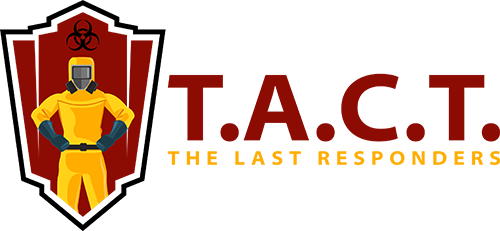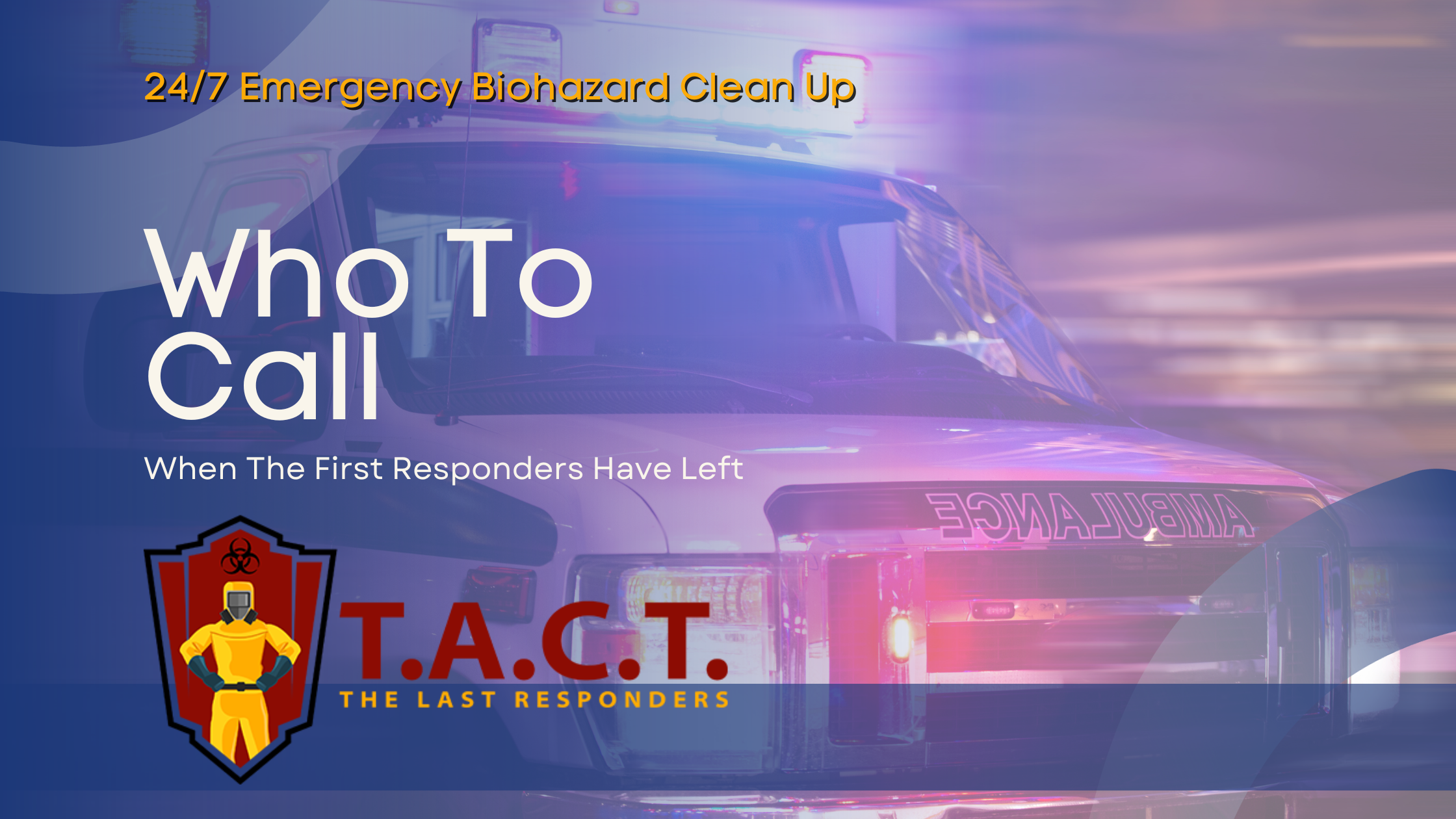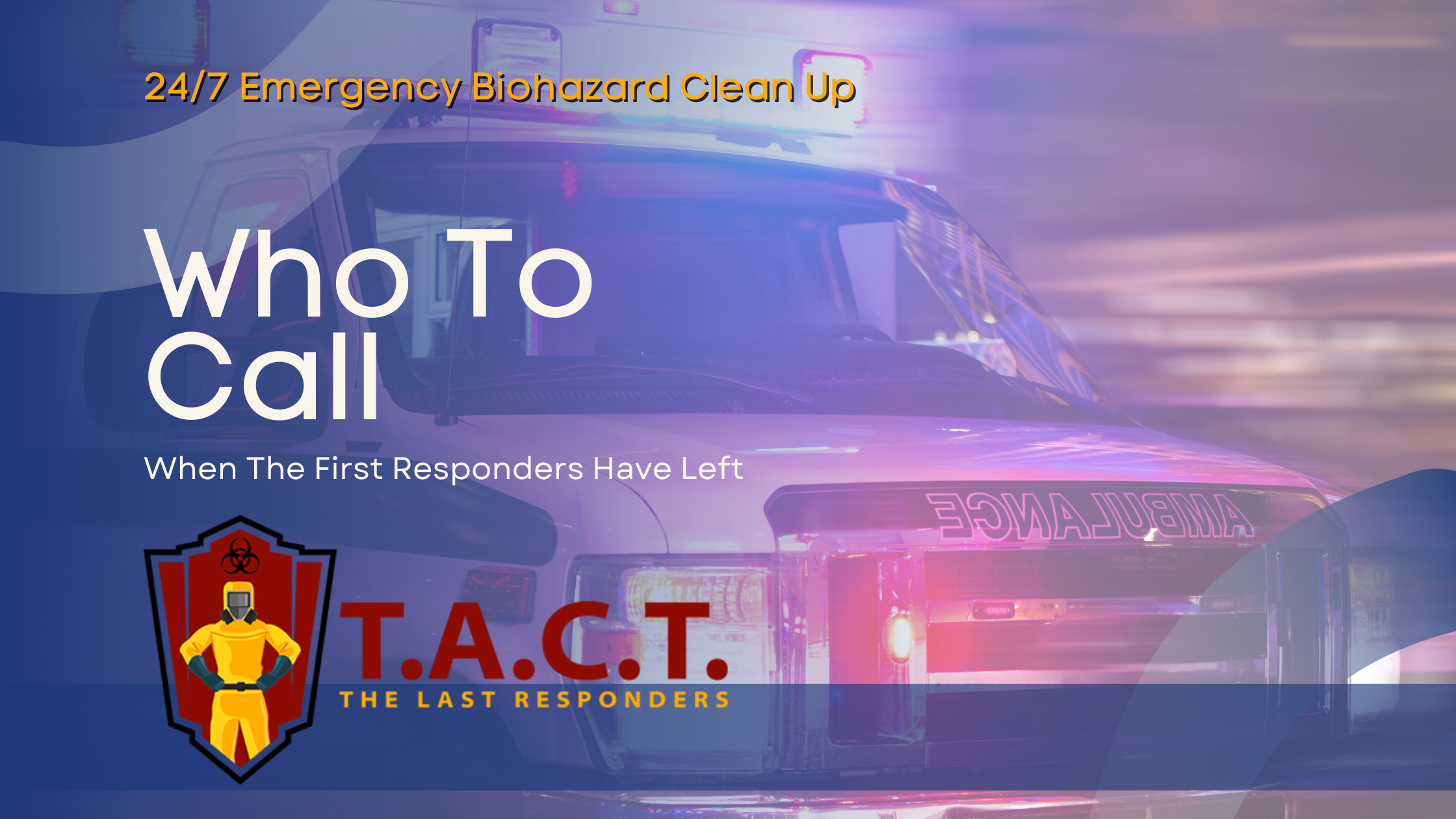How to manage quick tips long-term solutions
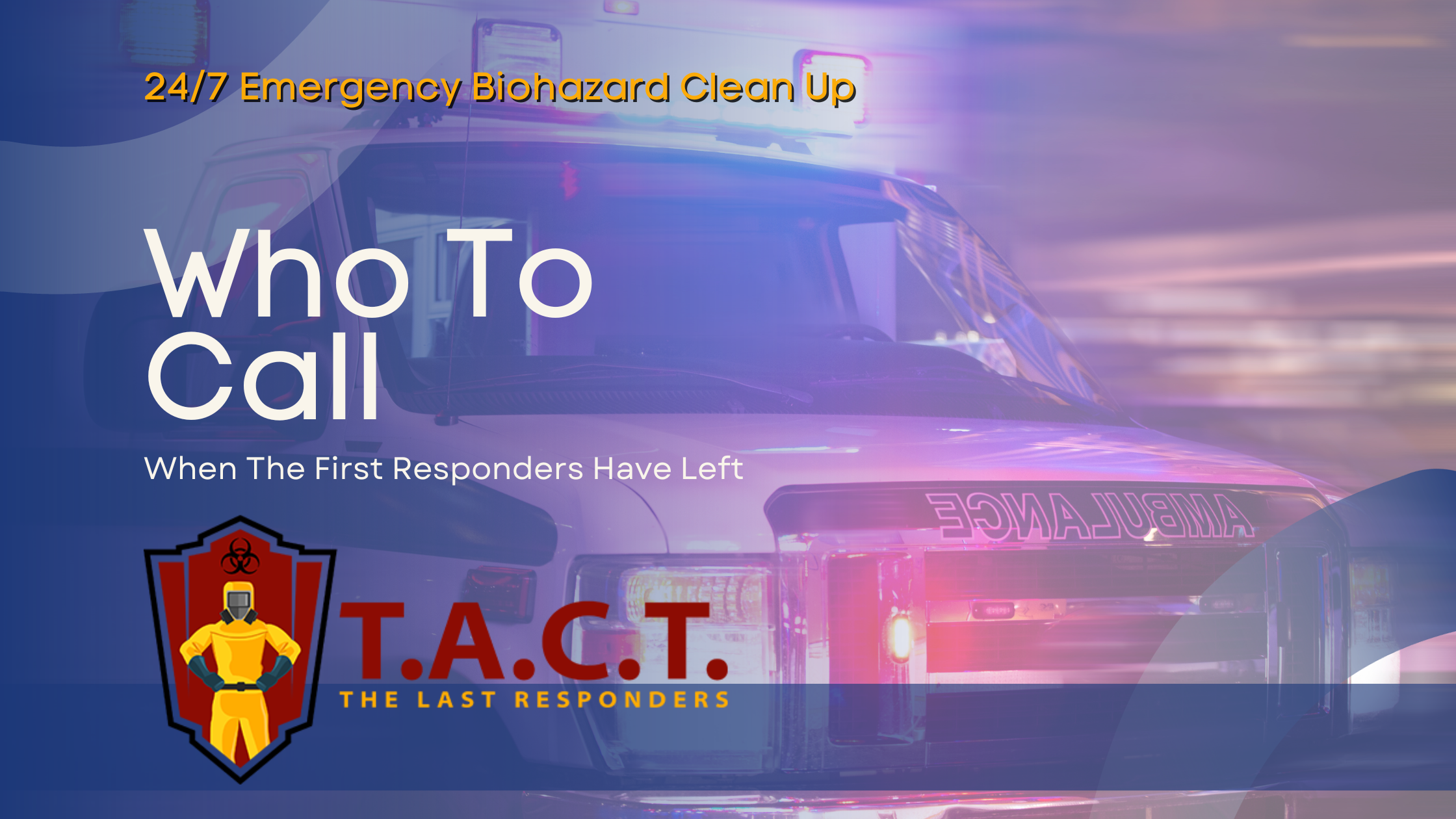
How to Manage Kitchen Fire Damage: Quick Tips and Long-Term Solutions
Facing kitchen fire damage? Start by ensuring safety, informing your insurance, and documenting all damage. This article will guide you through each essential step for handling a kitchen fire and beginning restoration.
Key Takeaways
Immediately prioritize safety by evacuating the area, calling emergency services, and documenting damage for insurance claims.
Assess both visible and hidden fire damage, as unnoticed structural issues can lead to long-term problems and require comprehensive restoration.
Prevent future kitchen fires by practicing safe cooking habits, installing smoke alarms, and keeping a fire extinguisher readily available.
Immediate Actions After a Kitchen Fire
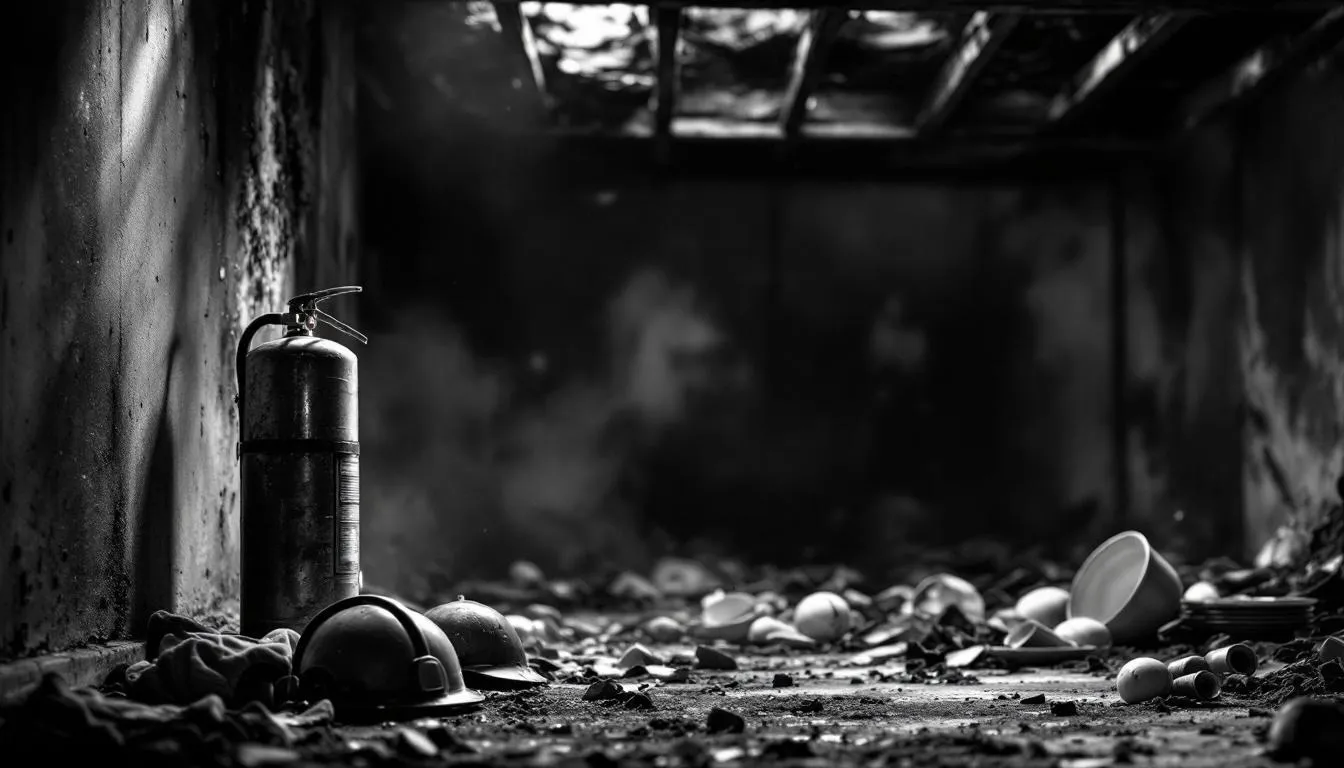
When a kitchen fire strikes, the first moments are critical. Panic can set in quickly, but knowing the proper steps can make all the difference. The primary focus should always be on safety: ensuring everyone evacuates the area and contacting emergency services. Kitchen fires start when proper precautions are not taken.
After addressing the immediate danger, contact your insurance company and document the damage for future restoration efforts. Here’s a detailed look at what you should do right after a kitchen fire.
Prioritize safety first:
Evacuate everyone and call the fire department immediately.
After the fire is controlled, contact your insurance company to start the claims process.
Thoroughly document all damage.
These actions set the foundation for effective restoration and ensure you have the necessary documentation for insurance claims.
Ensure Safety First
The foremost step after a kitchen fire is to ensure safety. Here’s what to do:
Evacuate the area immediately, prioritizing people over possessions.
Once everyone is out, call the fire department to handle the situation.
If the fire grows uncontrollable, do not attempt to extinguish it yourself—evacuation is crucial.
Having a fire extinguisher accessible in the kitchen can help suppress flames before they escalate, but it’s vital to know how to use it properly. For example:
If a large grease fire occurs, using a fire extinguisher is essential, or you should immediately contact emergency services.
Create a kid-free zone around the stove.
Keep protective gear like oven mitts handy to prevent accidents.
In a fire emergency, wear protective gear to avoid injuries. It shields you from heat, flames, and harmful smoke. Prioritizing safety sets the groundwork for effective firefighting efforts.
Contact Your Insurance Company
After the immediate danger has passed, follow these steps:
Contact your insurance company promptly to initiate the claims process.
This expedites the assessment and repair process.
Insurance companies will send an adjuster to assess the damage, which is essential for obtaining restoration funds.
Document all damage carefully and retain receipts for related expenses. This documentation supports your insurance claim, ensuring you receive the compensation needed for restoration. Detailed and accurate records smooth the claims process.
Document the Damage
Documenting damage after a kitchen fire is essential for insurance and restoration purposes. To do this effectively:
Take thorough photos of all visible damage.
Make detailed lists of all visible damage.
Include everything from charred cabinets and appliances to smoke-damaged walls and ceilings.
This documentation is invaluable for filing your insurance claim and planning restoration.
Also, note any structural damage or areas affected by firefighting water. Maintain detailed records to provide a comprehensive overview of the damage. This ensures no issue is overlooked and all necessary repairs are addressed.
Assessing Kitchen Fire Damage
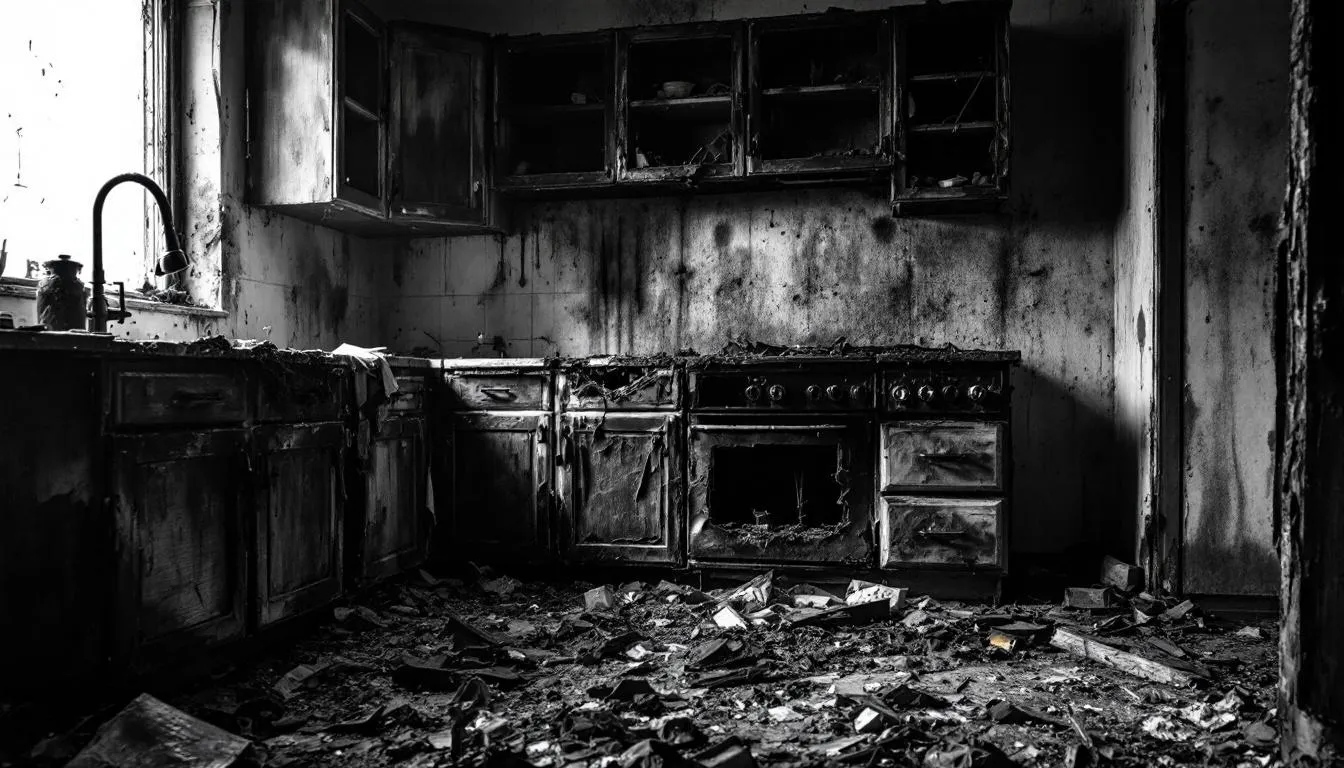
Assessing kitchen fire damage involves examining both visible and hidden damage. Visible damage includes blackened walls, melted fixtures, and destroyed appliances, while hidden damage affects the structural integrity of walls, floors, and ceilings. Proper assessment is key for effective fire damage restoration.
Professionals conduct thorough assessments, inspecting adjoining rooms and checking for smoke and soot damage. This comprehensive approach ensures all affected areas are identified for a complete restoration plan.
Visible Damage
Visible signs of kitchen fire damage are often alarming. Blackened walls, melted fixtures, and destroyed appliances are common after a fire. These damages are unsightly and can indicate significant structural issues. Countertops, flooring, and kitchen cabinets often need repair or replacement.
Surfaces like counters, cabinets, walls, and utensils are typically covered in soot after a fire. To prevent further damage, follow these steps:
Thoroughly clean these areas to remove all soot and smoke residues.
Promptly assess visible damage.
Address the damage as part of the restoration process, especially for painted surfaces.
Hidden Damage
Hidden damage from a kitchen fire can be as detrimental as visible damage. Fire can weaken walls, floors, and ceilings, potentially leading to structural collapse if not addressed. Smoke infiltrates walls and hidden areas, causing long-term damage that may not be immediately apparent.
Identifying smoke damage can be challenging, often manifesting through smell, sight, and feel on surfaces. Thorough assessment is required to ensure all hidden damage caused is properly restored, preventing future issues.
Cleaning Up After a Kitchen Fire
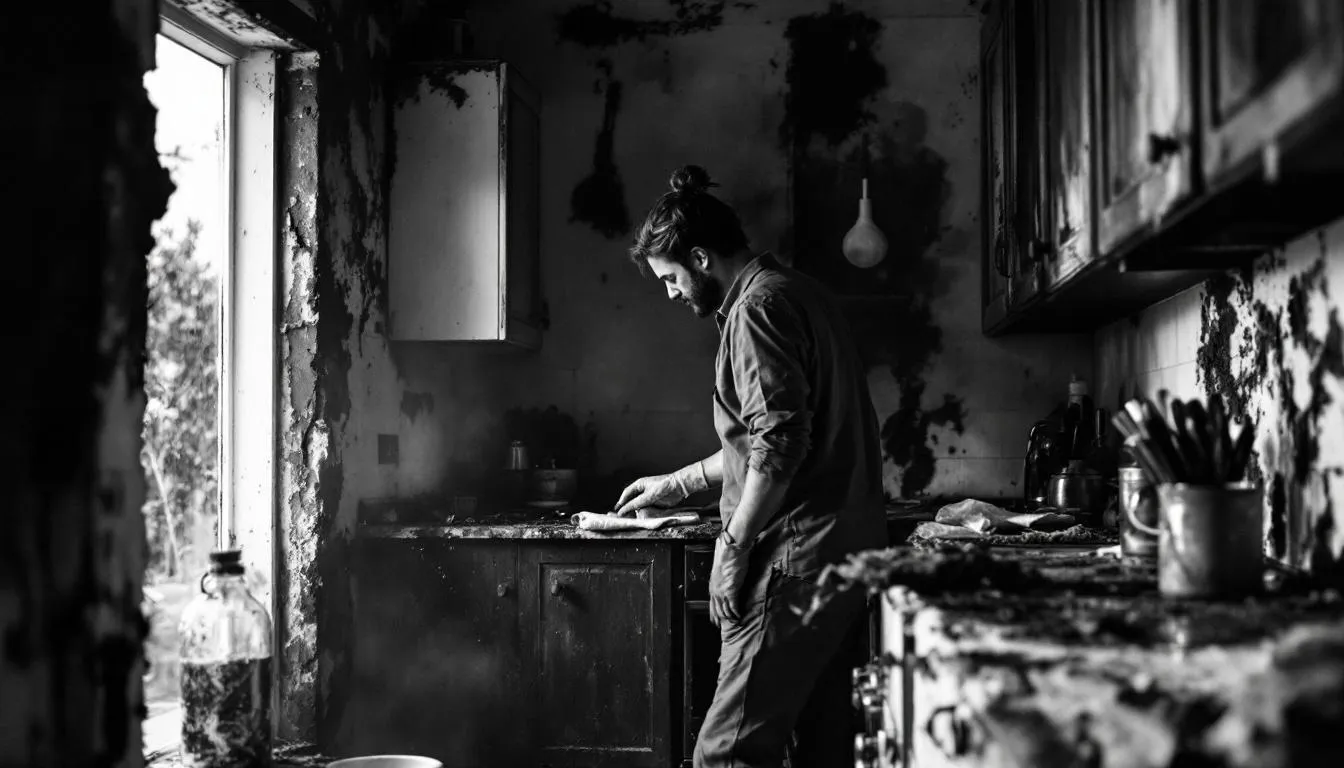
Cleaning up after a kitchen fire is a complex process not to be taken lightly. Here are some important guidelines:
Wait for professional guidance before starting cleanup to avoid exacerbating damage.
Delaying restoration can lead to increased damage and costs.
Begin the cleanup process as soon as it’s safe.
Cleanup involves removing any water, drying affected areas to prevent mold, and thoroughly cleaning surfaces to remove smoke and soot residues. Specialized cleaning products and techniques are essential for effective cleanup and preventing long-term health issues.
Removing Soot and Smoke Residue
Removing soot and smoke residue demands specialized equipment and techniques. Methods include ozone treatments and air filters, which effectively remove lingering smoke odors and soot particles. Incorrectly cleaning soot can spread residue and create permanent marks, so professional cleaning is recommended.
Eliminating lingering smoke odors is crucial for restoring comfort. This involves thorough cleaning and specialized equipment to remove all smoke and soot residues.
Dealing with Grease Fires
Grease fires present unique cleanup challenges due to high temperatures and stubborn oily residues. When a grease fire occurs, turn off the burner immediately and cover the flames to smother them. Using salt or baking soda can help extinguish the fire.
Cleaning up after a grease fire involves addressing visible soot and oily residues on cabinets, walls, and ceilings. This requires specialized cleaning products and techniques to thoroughly remove residues and restore the kitchen to a safe condition.
Cleaning Appliances
Cleaning kitchen appliances after a fire requires careful inspection and appropriate cleaning agents. For gas ovens, follow these steps:
Check for cracks in the walls and ceiling.
Inspect the gas line connector and other components for damage.
Turn off the pilot light.
Shut the gas valve before cleaning.
Use liquid dish soap and water to clean pots and pans, polishing if needed. Wash dishes with dish detergent, rinse with bleach, and then rinse with clean water to ensure they are safe to use.
Thoroughly clean all stove and oven surfaces before use.
Professional Fire Damage Restoration
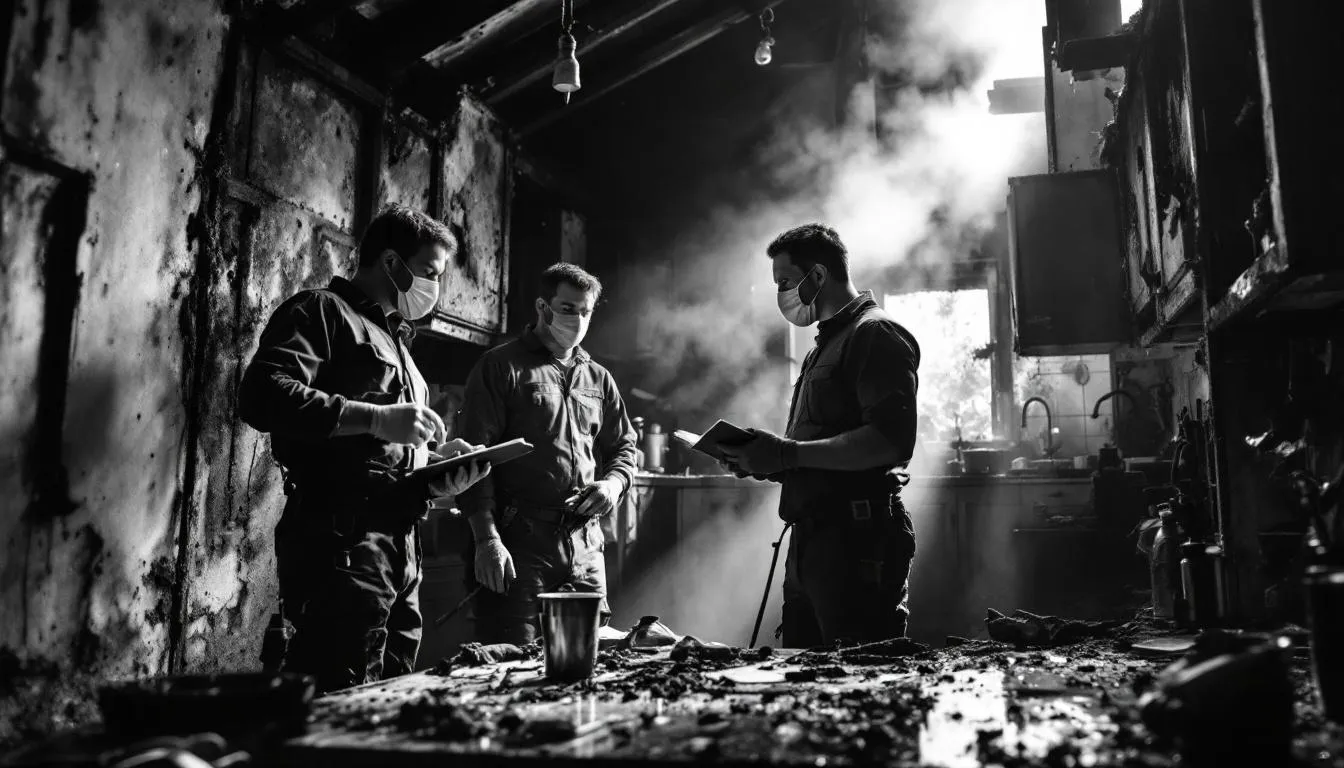
Hiring professional fire damage restoration services is crucial for managing the aftermath of a kitchen fire. Professionals have the expertise, equipment, and resources for proper assessment and repair. They handle everything from greasy residues and structural damage to embedded smoke particles.
The restoration process begins with an assessment, followed by cleanup and comprehensive restoration solutions. This ensures all damage is addressed, restoring your kitchen to its pre-loss condition.
Specialized Equipment
Professionals use specialized equipment like dehumidifiers and air movers to expedite drying and prevent further damage. They perform deep-cleaning services, including soot and smoke odor removal, to address issues presented by kitchen fires.
The repair process can involve minor repairs or rebuilding entire areas, depending on damage extent. Art, electronics, and documents can also be restored using specialized techniques and equipment.
Comprehensive Restoration Services
Comprehensive restoration services include:
Boarding up windows and walls
Roof tarping
Debris removal
Temporary power and lighting
Professionals handle smoke damage cleanup and odor removal to ensure a safe living environment.
Repairing or replacing walls, floors, and ceilings is essential for restoring a fire-damaged kitchen. Fire restoration involves removing water after firefighting, which is crucial to prevent further damage and ensure thorough restoration.
Preventing Secondary Damage
Preventing secondary damage is critical in fire damage restoration. If smoke particles are not handled properly, they can cause lingering odors and poor air quality. Addressing water damage from firefighting is essential to prevent mold growth.
Effective drying strategies are necessary to prevent mold growth and secondary damage. Properly managing residual odors or stains from grease fires ensures complete restoration.
Preventing Future Kitchen Fires
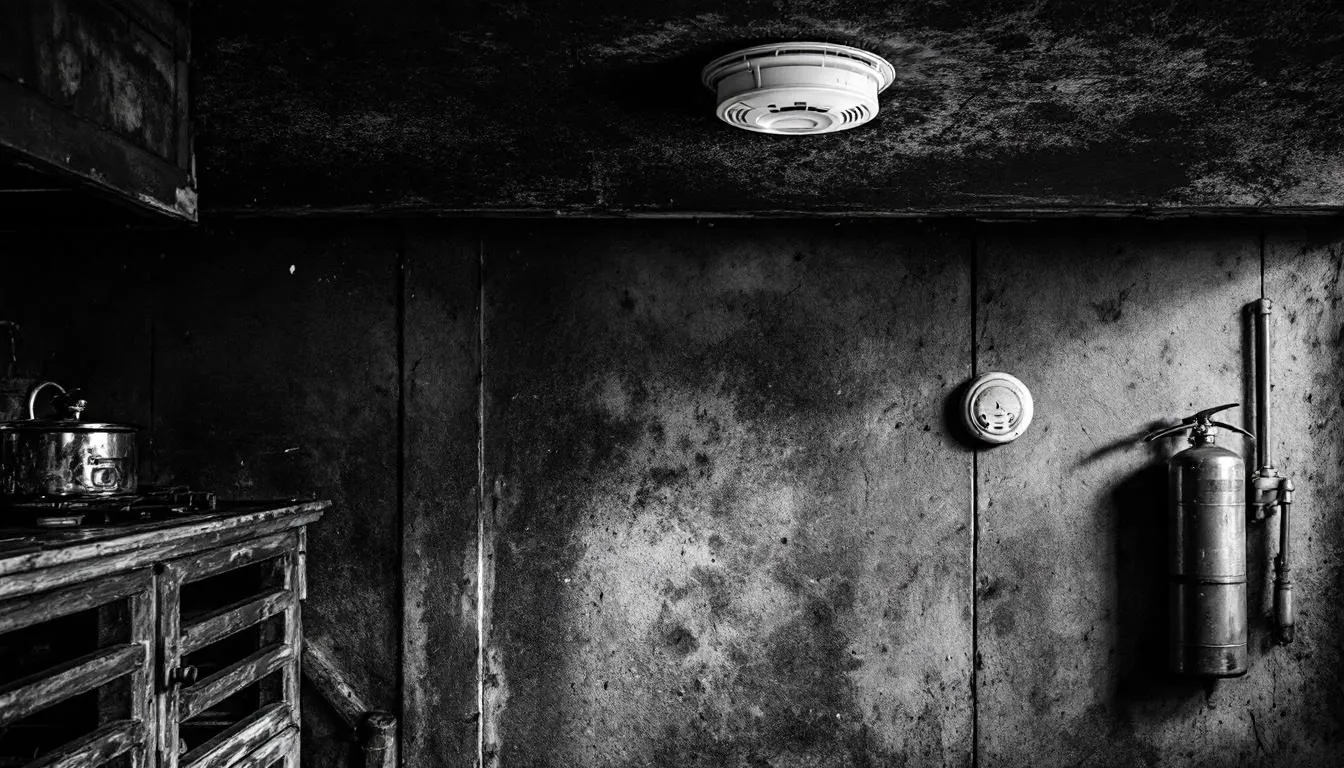
Preventing future kitchen fires involves safe cooking practices, installing smoke alarms, and keeping a fire extinguisher handy. Following fire safety tips from the National Fire Protection Association can significantly reduce the risk of cooking fires.
Keep combustible materials away from the stove and avoid cooking when tired or under the influence of alcohol.
Safe Cooking Practices
Safe cooking habits are one of the most effective ways to prevent kitchen fires. Key safety tips include:
Always turn off the stove if you need to leave the kitchen, even briefly.
Never leave cooking food unattended, as unattended cooking is a leading cause of kitchen fires.
Establish a kid-free zone of at least three feet around the stove to prevent accidents and reduce the risk of fires.
To reduce the risk of fire while cooking:
Keep flammable items like potholders, paper towels, and plastic containers away from the stove.
Turn pot handles toward the back of the stove to prevent accidental spills.
Wear close-fitting clothing or roll up sleeves while cooking.
In case of a small grease fire, use baking soda or cover the pan with a lid to smother the flames.
Installing Smoke Alarms
Installing smoke alarms is a crucial step in ensuring early detection of fires and minimizing damage. Smoke detectors provide early warnings that can save lives and reduce property damage. Installing a smoke alarm in the kitchen can catch fires early and enhance home safety.
Interconnected smoke alarms provide the greatest protection. They all sound the alarm simultaneously when one detects smoke. Regular maintenance of smoke detectors, including testing them monthly and replacing batteries annually, is essential for effective fire detection.
Keeping a Fire Extinguisher Handy
Keeping a fire extinguisher in the kitchen is essential for handling fire emergencies. Store the fire extinguisher in an easily accessible location, such as a closet or cabinet, or on a shelf if no closet is available. Knowing how to use the fire extinguisher properly can help you manage small fires before they escalate and cause significant damage.
Having a fire extinguisher handy can make all the difference when a fire strikes. Being prepared and knowing how to respond quickly can prevent a small fire from turning into a devastating house fire. Fire extinguishers can be a crucial tool in this preparation.
Regularly check the fire extinguisher to ensure it’s in working condition and familiarize yourself with its operation.
Summary
Managing kitchen fire damage involves immediate actions, thorough assessment, effective cleanup, professional restoration, and preventive measures. Ensuring safety first, contacting your insurance company, and documenting the damage are critical steps in the aftermath of a fire. Assessing both visible and hidden damage ensures that all areas affected by the fire are addressed.
Cleaning up after a kitchen fire requires specialized equipment and techniques to remove soot, smoke, and residues. Hiring professional restoration services can provide comprehensive solutions to restore your kitchen to its pre-loss condition. Preventing future kitchen fires through safe cooking practices, installing smoke alarms, and keeping a fire extinguisher handy can significantly reduce the risk of fires and ensure your family’s safety.
By following these guidelines, you can effectively manage the aftermath of a kitchen fire and take proactive steps to prevent future incidents. Remember, safety and preparedness are key to protecting your home and loved ones from the dangers of kitchen fires.
Frequently Asked Questions
What should I do immediately after a kitchen fire?
Immediately evacuate the area and call emergency services to ensure safety. Afterward, contact your insurance company and document the damage.
How can I assess the damage after a kitchen fire?
To accurately assess the damage after a kitchen fire, examine both visible and hidden issues such as structural integrity, smoke residue, and water damage. It's best to consult a professional for a comprehensive evaluation.
What are the best practices for cleaning up after a kitchen fire?
The best practice for cleaning up after a kitchen fire is to hire professional restoration services that utilize specialized equipment to effectively remove soot and smoke residues, thereby preventing long-term damage. This approach ensures a thorough cleanup and helps restore your kitchen to its pre-fire condition.
How can I prevent future kitchen fires?
To prevent future kitchen fires, always practice safe cooking methods, install smoke alarms, and keep a fire extinguisher readily accessible. It's crucial to never leave cooking unattended and to keep flammable items away from heat sources.
Why is it important to hire professional fire damage restoration services?
Hiring professional fire damage restoration services is crucial as they possess the expertise and specialized equipment to effectively assess and restore the affected areas, ultimately preventing further damage and ensuring a safe environment.
Latest news
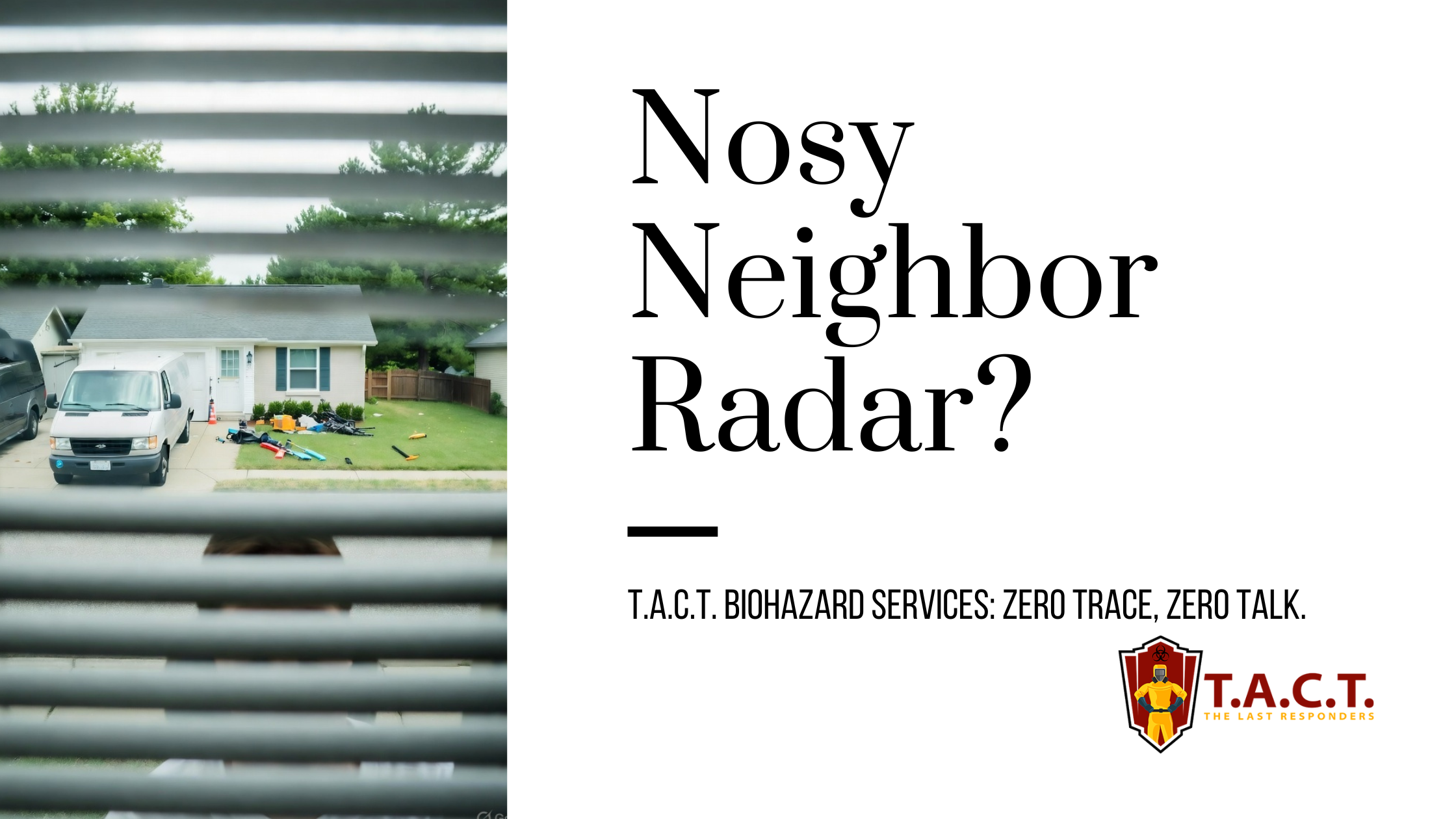
Nosy neighbors peeking? T.A.C.T. North Atlanta offers discreet biohazard remediation for rodent infestations, mold, hoarding, and more. Unmarked vehicles, quiet experts, full privacy—24/7 service at 470-781-4775.
Read More